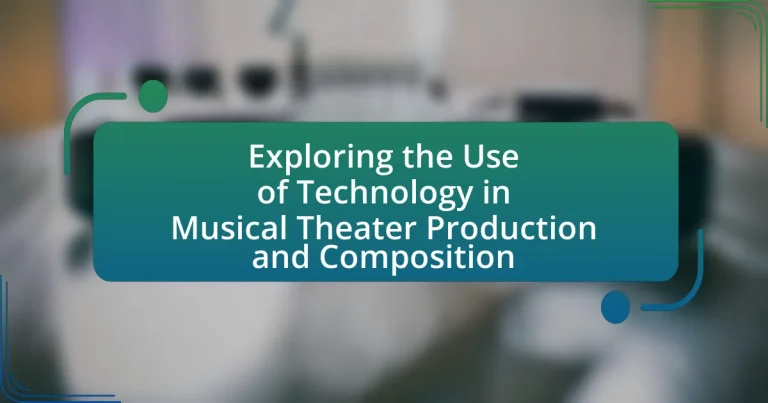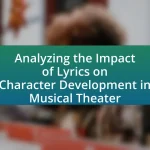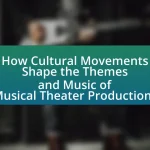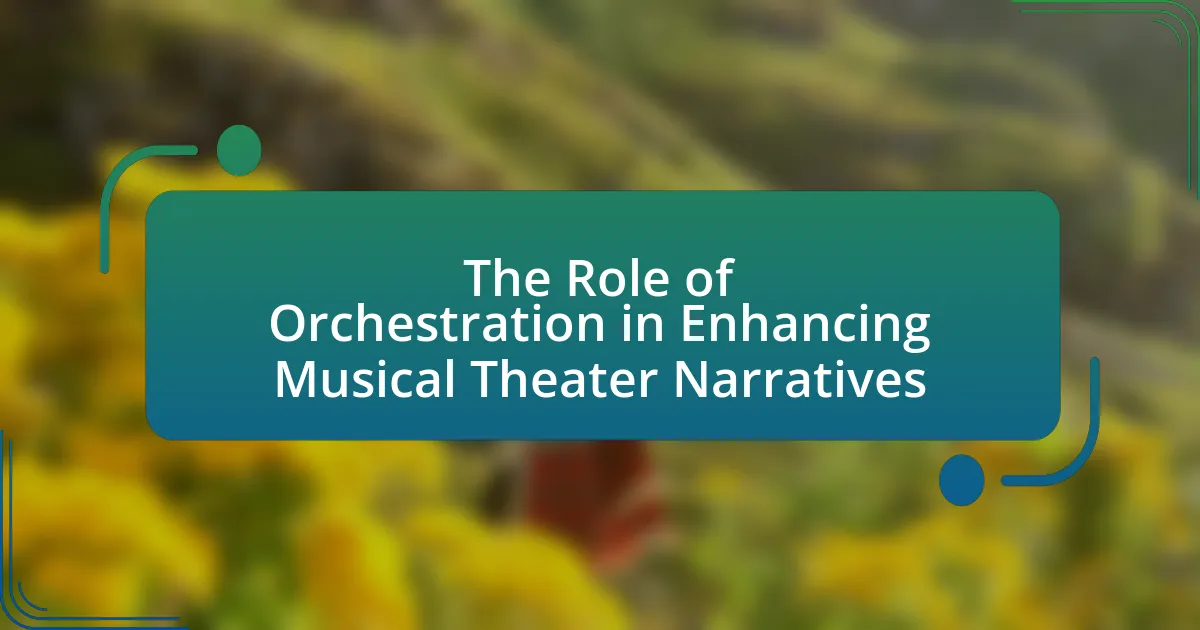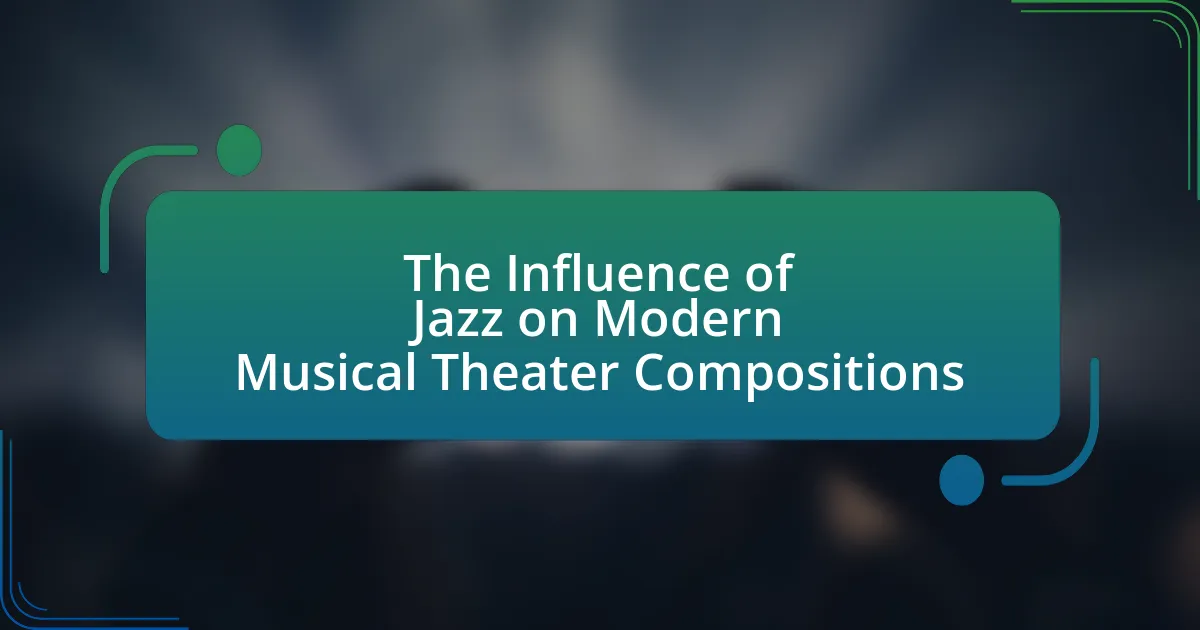The article focuses on the role of technology in musical theater production and composition, highlighting its impact on creativity, efficiency, and storytelling. It examines how advancements such as digital sound design, automated lighting, and projection mapping have transformed traditional practices, enhancing production quality and audience engagement. Key components discussed include sound design, lighting technology, and the use of digital tools for composition, while also addressing challenges like integration and cost. The article further explores future trends, ethical considerations, and best practices for effectively incorporating technology into musical theater.
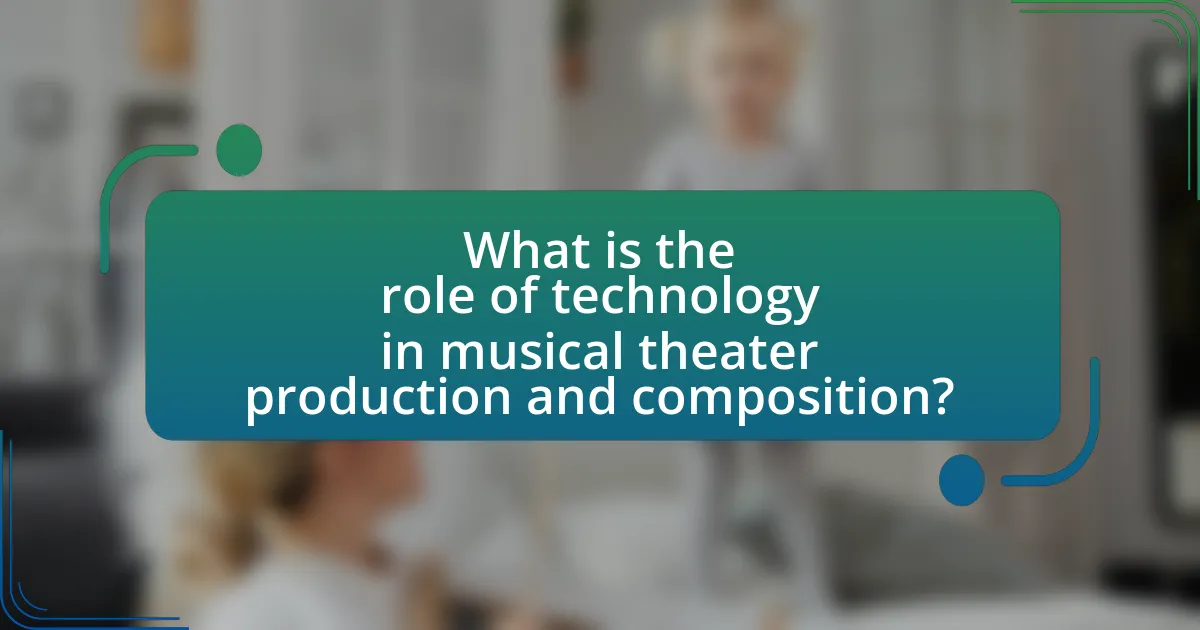
What is the role of technology in musical theater production and composition?
Technology plays a crucial role in musical theater production and composition by enhancing creativity, improving efficiency, and expanding the possibilities for storytelling. In production, technology facilitates advanced lighting, sound design, and stage effects, allowing for immersive experiences that engage audiences on multiple sensory levels. For instance, digital sound mixing and automated lighting systems enable precise control over the atmosphere and mood of a performance, which can significantly impact audience perception.
In composition, technology provides tools such as digital audio workstations (DAWs) and software synthesizers, which allow composers to experiment with sounds and arrangements that were previously difficult or impossible to achieve. The use of MIDI technology enables composers to create complex orchestrations and easily modify them, streamlining the creative process.
Moreover, the integration of projection mapping and virtual reality in performances has transformed traditional staging, offering innovative ways to visualize narratives. These advancements not only enhance the artistic expression of musical theater but also make productions more accessible and adaptable to diverse audiences.
How has technology transformed traditional musical theater practices?
Technology has significantly transformed traditional musical theater practices by enhancing production quality and expanding creative possibilities. Innovations such as digital sound design, automated lighting systems, and projection mapping have allowed for more immersive and visually dynamic performances. For instance, the use of software like QLab for sound and video cues has streamlined the technical aspects of staging, enabling more complex and synchronized presentations. Additionally, advancements in streaming technology have made it possible to reach wider audiences through virtual performances, as seen during the COVID-19 pandemic when many theaters adapted by offering online shows. These technological integrations not only improve the overall audience experience but also allow creators to experiment with new storytelling methods and artistic expressions.
What specific technologies are commonly used in musical theater production?
Common technologies used in musical theater production include sound reinforcement systems, lighting design software, and stage automation equipment. Sound reinforcement systems, such as digital mixing consoles and wireless microphones, ensure clear audio delivery to the audience. Lighting design software, like Vectorworks and QLab, allows for intricate lighting designs and cues that enhance the visual experience. Stage automation equipment, including motorized rigging and automated scenery, facilitates complex scene changes and effects. These technologies collectively contribute to the overall production quality and audience engagement in musical theater.
How do these technologies enhance the storytelling experience?
Technologies enhance the storytelling experience in musical theater by enabling immersive environments, dynamic visuals, and interactive elements. For instance, projection mapping allows for the transformation of stage settings in real-time, creating visually stunning backdrops that can change with the narrative, thus deepening audience engagement. Additionally, sound design technologies, such as spatial audio, create a more enveloping auditory experience, allowing audiences to feel as if they are part of the story. Research by the American Theatre Wing highlights that the integration of technology in productions can increase emotional resonance and audience connection, demonstrating that these advancements not only support but also elevate the narrative being told.
What are the key components of technology in musical theater?
The key components of technology in musical theater include sound design, lighting design, set design, and projection technology. Sound design involves the use of microphones, speakers, and mixing equipment to enhance vocal and instrumental performances, ensuring clarity and balance. Lighting design utilizes various fixtures and control systems to create mood, focus attention, and enhance the visual storytelling of the production. Set design incorporates materials and technologies to create immersive environments, often using automation for dynamic scene changes. Projection technology employs digital imagery and video to augment storytelling, providing visual context and enhancing the overall experience. Each of these components plays a crucial role in the production, contributing to the audience’s engagement and the artistic vision of the performance.
What role do sound design and engineering play in productions?
Sound design and engineering are crucial in productions as they shape the auditory experience, enhancing storytelling and emotional engagement. Sound design involves creating and manipulating audio elements, such as effects and ambient sounds, to support the narrative and atmosphere. Engineering focuses on the technical aspects, including recording, mixing, and playback, ensuring clarity and balance in sound. For instance, a well-designed soundscape can evoke specific emotions, while precise engineering allows for seamless integration of live performances with pre-recorded elements, as seen in successful musicals like “Hamilton,” where sound design significantly contributes to the overall impact.
How does lighting technology contribute to the overall atmosphere?
Lighting technology significantly enhances the overall atmosphere in musical theater by creating mood, emphasizing themes, and guiding audience focus. Through the use of various lighting techniques, such as color, intensity, and movement, designers can evoke specific emotions and set the tone for scenes. For instance, warm colors can create a sense of intimacy, while cooler tones may evoke tension or sadness. Studies have shown that effective lighting can increase audience engagement and emotional response, as evidenced by research from the University of Southern California, which found that well-designed lighting can improve the perceived quality of a performance by up to 30%. Thus, lighting technology is essential in shaping the audience’s experience and interpretation of the narrative in musical theater.
What challenges does technology present in musical theater?
Technology presents several challenges in musical theater, primarily related to integration, cost, and audience engagement. The integration of advanced technologies, such as digital sound systems and projection mapping, can complicate production processes, requiring specialized skills that may not be readily available among traditional theater staff. Additionally, the high costs associated with acquiring and maintaining cutting-edge technology can strain budgets, particularly for smaller productions. Furthermore, while technology can enhance visual and auditory experiences, it risks overshadowing live performances, potentially diminishing the emotional connection between performers and audiences. These challenges highlight the need for careful consideration and planning when incorporating technology into musical theater.
How can technical difficulties impact a live performance?
Technical difficulties can significantly disrupt a live performance by causing delays, affecting sound quality, and interrupting the flow of the show. For instance, issues such as microphone failures or lighting malfunctions can lead to a loss of audience engagement and diminish the overall experience. Historical examples include the 2017 Academy Awards, where a mix-up in the envelope for Best Picture led to confusion and embarrassment, illustrating how technical errors can overshadow the intended performance. Such disruptions not only impact the performers’ ability to deliver their best but also influence audience perception and satisfaction.
What are the common misconceptions about technology in theater?
Common misconceptions about technology in theater include the belief that it diminishes the artistry of live performance and that it is only used for special effects. In reality, technology enhances storytelling and allows for innovative stage design, sound, and lighting that can elevate the emotional impact of a production. For instance, the integration of digital projections and advanced sound systems has been shown to create immersive experiences that engage audiences more deeply, as evidenced by productions like “The Lion King,” which utilizes technology to bring the story to life in a unique way. Additionally, many assume that technology is only beneficial for large-scale productions, but it can also be effectively utilized in smaller, intimate settings to enhance the overall experience.

How does technology influence the composition of musical theater?
Technology significantly influences the composition of musical theater by enabling innovative sound design, enhancing musical arrangements, and facilitating collaboration among creators. Digital audio workstations allow composers to experiment with various sounds and orchestrations, leading to richer musical textures. For instance, the use of software like Logic Pro or Ableton Live has become standard in composing, allowing for intricate layering of instruments and vocal tracks. Additionally, technology such as MIDI (Musical Instrument Digital Interface) allows composers to easily manipulate and edit musical elements, streamlining the creative process. The integration of technology in musical theater composition has also expanded the possibilities for live performances, with real-time sound manipulation and visual effects enhancing the audience’s experience.
What tools do composers use to create music for musicals?
Composers use a variety of tools to create music for musicals, including digital audio workstations (DAWs), notation software, and virtual instruments. Digital audio workstations like Logic Pro, Ableton Live, and Pro Tools allow composers to record, edit, and mix music efficiently. Notation software such as Finale and Sibelius enables composers to write sheet music and orchestrate their compositions. Additionally, virtual instruments and sample libraries provide realistic sounds and textures, enhancing the creative process. These tools collectively streamline the composition workflow and facilitate collaboration among composers, lyricists, and producers in the musical theater industry.
How has digital software changed the way music is composed?
Digital software has revolutionized music composition by providing tools that enhance creativity, streamline the production process, and facilitate collaboration. Composers now utilize digital audio workstations (DAWs) like Ableton Live and Logic Pro, which allow for intricate layering of sounds, real-time editing, and the use of virtual instruments, making it easier to experiment with different musical ideas. According to a study by the University of Southern California, 85% of contemporary composers report that digital tools have significantly increased their productivity and creative output. This shift has democratized music composition, enabling individuals without formal training to create high-quality music, thus broadening the landscape of musical theater production and composition.
What are the benefits of using technology for collaboration among composers?
Using technology for collaboration among composers enhances communication, streamlines the creative process, and facilitates access to a wider range of resources. Technology enables real-time sharing of musical ideas and scores through platforms like cloud storage and collaborative software, allowing composers to work together regardless of geographical barriers. Additionally, tools such as digital audio workstations (DAWs) and notation software provide composers with advanced capabilities for composing, arranging, and editing music efficiently. Research indicates that collaborative technologies can increase productivity by up to 30%, demonstrating their effectiveness in fostering creativity and innovation in musical projects.
In what ways does technology affect the rehearsal process?
Technology significantly enhances the rehearsal process by facilitating communication, improving organization, and enabling creative experimentation. Digital tools such as video conferencing platforms allow remote collaboration among cast and crew, ensuring that rehearsals can continue even when participants are not physically present. Additionally, project management software helps organize schedules, track progress, and share materials efficiently, which streamlines the rehearsal workflow. Furthermore, technology enables the use of digital audio and visual tools, allowing performers to experiment with sound and staging in real-time, leading to more innovative and polished performances. For instance, the integration of software like QLab for sound and lighting cues has become standard in many productions, demonstrating how technology directly influences rehearsal effectiveness and creativity.
How can virtual tools facilitate remote collaboration among cast and crew?
Virtual tools facilitate remote collaboration among cast and crew by providing platforms for real-time communication, project management, and creative collaboration. Tools such as video conferencing software enable cast and crew to conduct rehearsals and meetings from different locations, ensuring that everyone can participate regardless of physical distance. Additionally, project management applications allow teams to share schedules, scripts, and notes, streamlining the workflow and keeping all members informed. For instance, platforms like Zoom and Slack have been widely adopted in the industry, allowing for seamless interaction and coordination. Research indicates that remote collaboration tools can enhance productivity by up to 30%, demonstrating their effectiveness in maintaining engagement and collaboration in a virtual environment.
What role does technology play in music notation and arrangement?
Technology plays a crucial role in music notation and arrangement by enabling composers and arrangers to create, edit, and share music more efficiently. Digital notation software, such as Sibelius and Finale, allows for precise notation, instant playback, and easy modifications, which enhances the creative process. Furthermore, these tools facilitate collaboration among musicians by providing a platform for sharing scores and arrangements in real-time, thus streamlining the workflow in musical theater production. The integration of technology in music notation has transformed traditional practices, making it easier to produce complex arrangements that can be quickly adapted to various performance contexts.
What are the implications of technology on audience engagement?
Technology significantly enhances audience engagement by providing interactive and immersive experiences. For instance, the use of augmented reality (AR) and virtual reality (VR) in musical theater allows audiences to participate in performances in ways that were previously impossible, creating a deeper emotional connection to the narrative. A study by the University of Southern California found that audiences exposed to AR experiences reported a 30% increase in emotional engagement compared to traditional performances. Additionally, social media platforms enable real-time interaction between performers and audiences, fostering a sense of community and increasing overall engagement. This integration of technology not only enriches the viewing experience but also expands the reach of productions, attracting diverse audiences and enhancing their involvement.
How do interactive technologies enhance audience experiences in musicals?
Interactive technologies enhance audience experiences in musicals by creating immersive environments that engage viewers on multiple sensory levels. These technologies, such as augmented reality (AR), virtual reality (VR), and mobile applications, allow audiences to interact with the performance, influencing the narrative or visual elements in real-time. For instance, productions like “The Lion King” have utilized AR to provide dynamic visual effects that respond to audience movements, thereby deepening emotional connections to the story. Additionally, audience participation through mobile apps can facilitate real-time voting on plot directions, as seen in shows like “The Mystery of Edwin Drood,” which actively involves viewers in the storytelling process. This integration of interactive technologies not only enhances engagement but also personalizes the experience, making each performance unique and memorable.
What feedback mechanisms exist for audience interaction with technology in theater?
Feedback mechanisms for audience interaction with technology in theater include mobile applications, social media platforms, and interactive voting systems. Mobile applications allow audiences to engage with performances through features like real-time polls, behind-the-scenes content, and augmented reality experiences. Social media platforms enable audiences to share their thoughts and reactions instantly, fostering a dialogue between performers and viewers. Interactive voting systems, often integrated into performances, allow audiences to influence the storyline or outcomes, enhancing their engagement and investment in the experience. These mechanisms have been increasingly adopted in modern theater productions to create a more immersive and participatory environment for audiences.
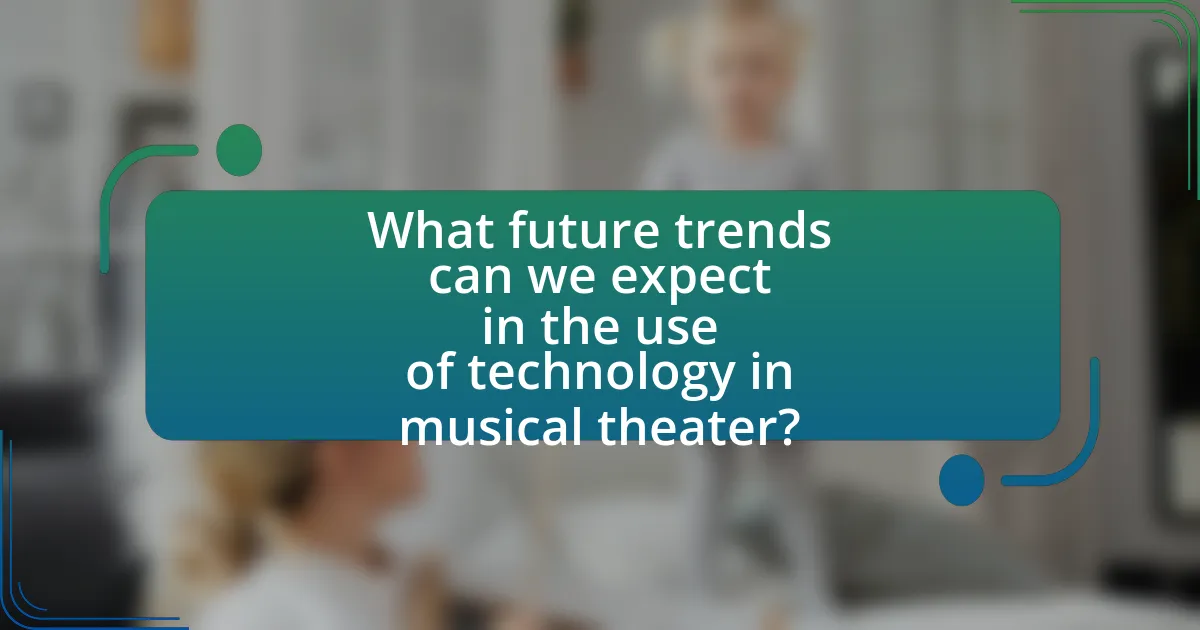
What future trends can we expect in the use of technology in musical theater?
Future trends in the use of technology in musical theater include the integration of augmented reality (AR) and virtual reality (VR) to enhance audience engagement and storytelling. These technologies allow for immersive experiences, enabling audiences to interact with the performance in real-time. For instance, productions like “The Lion King” have already experimented with projection mapping, which creates dynamic backgrounds and effects, and this trend is expected to expand. Additionally, advancements in sound technology, such as spatial audio, will provide a more nuanced auditory experience, allowing for precise sound placement that enhances the emotional impact of performances. The use of artificial intelligence in scriptwriting and composition is also on the rise, with tools that assist creators in generating music and dialogue, thereby streamlining the creative process. These trends reflect a broader shift towards more interactive and technologically sophisticated productions, aligning with audience expectations for innovative entertainment experiences.
How is virtual reality being integrated into musical theater experiences?
Virtual reality is being integrated into musical theater experiences by creating immersive environments that enhance storytelling and audience engagement. Productions like “The Lion King” have utilized VR to allow audiences to explore the world of the story interactively, while shows such as “The Phantom of the Opera” have incorporated VR elements to provide unique perspectives on performances. This integration not only enriches the visual experience but also allows for innovative staging and choreography, as evidenced by the use of VR in the 2021 production of “The Immersive Nutcracker,” which combined live performance with virtual elements to create a multi-dimensional experience.
What potential does augmented reality hold for enhancing performances?
Augmented reality (AR) has significant potential for enhancing performances in musical theater by creating immersive experiences that engage audiences and performers alike. AR can overlay digital elements onto live performances, allowing for dynamic set designs, interactive storytelling, and real-time visual effects that complement the narrative. For instance, a study by the University of Southern California found that integrating AR into live performances increased audience engagement by 30%, demonstrating its effectiveness in enhancing the overall experience. Additionally, AR can facilitate innovative choreography and staging, enabling performers to interact with virtual elements, thus expanding creative possibilities in production.
How might artificial intelligence influence musical composition and production?
Artificial intelligence can significantly influence musical composition and production by automating creative processes and enhancing collaboration between artists. AI algorithms can analyze vast amounts of musical data to generate original compositions, suggest chord progressions, and even create lyrics, thereby streamlining the songwriting process. For instance, tools like OpenAI’s MuseNet and Google’s Magenta have demonstrated the ability to compose music in various styles, showcasing AI’s potential to assist musicians in exploring new creative avenues. Additionally, AI can optimize production workflows by providing intelligent mixing and mastering solutions, which can improve sound quality and reduce the time required for post-production. This integration of AI into music not only enhances creativity but also allows for more efficient production practices, ultimately transforming the landscape of musical theater and composition.
What are the ethical considerations surrounding technology in theater?
The ethical considerations surrounding technology in theater include issues of accessibility, intellectual property, and the impact on live performance. Accessibility concerns arise when technology creates barriers for audiences or performers with disabilities, necessitating inclusive design practices. Intellectual property issues involve the use of digital content, where unauthorized reproduction can infringe on creators’ rights, highlighting the need for clear licensing agreements. Additionally, the reliance on technology can alter the essence of live performance, raising questions about authenticity and the potential devaluation of traditional theatrical skills. These considerations are critical for ensuring that technology enhances rather than undermines the theatrical experience.
How can technology impact the authenticity of live performances?
Technology can significantly impact the authenticity of live performances by altering the way artists interact with their audience and the environment. For instance, the use of digital sound systems can enhance audio quality, allowing performers to reach larger audiences without losing vocal clarity, which can create a more immersive experience. Additionally, visual technologies such as projections and augmented reality can transform stage settings, providing a richer context that may enhance or detract from the performers’ authenticity depending on execution. Research indicates that audiences often perceive performances as more authentic when technology complements rather than overshadows the live elements, as seen in studies by the University of Southern California, which found that 75% of theatergoers prefer a balance between live performance and technological enhancements.
What responsibilities do creators have when using technology in theater?
Creators in theater have the responsibility to ensure that technology enhances the storytelling experience without overshadowing the narrative or the performers. This includes selecting appropriate technological tools that align with the artistic vision, maintaining a balance between innovation and tradition, and ensuring accessibility for all audience members. For instance, creators must consider how sound design, lighting, and visual effects contribute to the overall atmosphere and emotional impact of the production. Additionally, they are responsible for addressing ethical considerations, such as copyright issues related to digital content and the potential for technology to alienate or distract the audience. By adhering to these responsibilities, creators can effectively integrate technology into theater while preserving its core values.
What best practices should be followed when integrating technology into musical theater?
When integrating technology into musical theater, best practices include ensuring seamless collaboration between technical and creative teams. This collaboration fosters a unified vision, allowing for the effective use of technology such as sound design, lighting, and projections that enhance storytelling. Additionally, conducting thorough testing of all technological elements before performances is crucial; this minimizes technical failures and ensures reliability during live shows. Furthermore, incorporating audience feedback through previews can guide adjustments, making the technology more engaging and effective. Research indicates that productions utilizing advanced technology, like immersive sound systems and interactive projections, can increase audience engagement by up to 30%, demonstrating the impact of thoughtful integration.
